MusicRadar Verdict
While some new features are better implemented than others, Live 12 is a generous update stuffed with ideas and real potential.
Pros
- +
UI changes add in real flexibility to Live’s workflow.
- +
Meld and Roar are both deep and powerful, but also fun and approachable.
- +
Generative MIDI tools offer a deep well of creative experimentation.
Cons
- -
The revamped browser requires a bit of time and effort to get the most from.
- -
Implementation of some MIDI tools feels a little messy.
- -
No way to use MIDI generation or transformation from Push.
MusicRadar's got your back
Ableton Live 12 Suite: What is it?
Most DAW updates are sold on the back of flashy new features, but really what a DAW lives or dies on is consistency. Whether used in a professional or hobby capacity, these are foundational platforms for modern music makers. A transition from one version to another needs to be as seamless as possible. While the promise of exciting new features might be what sells a user on paying for the latest updates, it’s the small, incremental enhancements to an application’s workflow that make them stick around for the long term.
Traditionally, this is something Ableton has been good at. For all of the devices added in the 22 years since it launched, Live’s overall design has remained remarkably consistent. So much so that it would be possible to skip several versions when updating and still encounter few unexpected roadblocks, since most elements will be where you’d expect them: the browser to the left, devices down the bottom, clip launcher and arrangement living in their own individual UI views. Version 12 is arguably Live’s most significant update in over a decade because it’s the first time that Ableton has risked messing with this familiarity.
Ableton Live 12 Suite: Performance and verdict
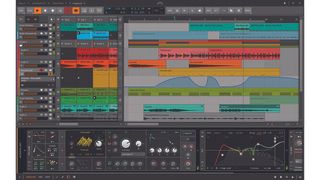
• Bitwig Studio
Live’s closest competitor, also recently updated. Bitwig arguably offers more depth and flexibility, but loses some of Live’s slick immediacy.
• Apple Logic Pro
For Mac owners, Logic would be the best value DAW on the market, and recent years have seen it adopt more and more Live-inspired ideas.
• Image-Line FL Studio
Often wrongly derided as an ‘entry level’ DAW, like Live, FL Studio has a unique workflow that’s well suited to electronic music.
This is most evident in the layout of the UI. Previous versions of Live have maintained fairly rigorous constraints on how its workspace can be arranged. While it’s been possible to resize certain elements to an extent, and hide/show others, there have always been hard-and-fast rules about how Live is laid out. The clip launcher and timeline live in separate windows; the Mixer is only available in Session view; clip and device parameters can’t be viewed side-by-side.
Version 12 does away with a lot of these constraints and makes the UI far more flexible. While the divide between the clip-launching Session view and Arrangement timeline remains, it’s now possible to call up the mixer, clip and device panels from anywhere. This means you can use the Mixer alongside the Arrangement view, but also display MIDI or audio clips alongside device interfaces simultaneously, mostly within a single window.
Admittedly, this can feel a little on the cluttered side with everything displayed at once – particularly on a laptop screen – but the flexibility it adds to Live’s workflow is a real benefit. For those used to quickly tabbing between views and using familiar keyboard shortcuts to show/hide elements, the new interaction between these elements may take a little getting used to, but once it becomes familiar, there’s no going back. Out of curiosity, we returned to Live 11 after using 12 for several weeks, and the old UI already feels remarkably restrictive.
The UI element that took us a little longer to get to grips with is Live’s revamped Library browser. This modernises the way users find devices, clips, samples and other content, doing away with the previous system of sub-folders in favour of dynamic tags and filters. On the one hand, this new system is objectively better – there’s more flexibility, particularly when it comes to saving custom search parameters, and it means there’s less of a divide between content types. A top-level search for ‘bass’, for example, will bring up a long list of device presets, clips, loops and samples, which can be filtered down by content type, source or sound characteristics. If the resulting combination of search terms and filters is something you’re likely to use again, hitting the ‘+’ symbol next to the results will add it to the library sidebar, creating a shortcut that will be updated as new content is imported or tagged.
The system does, however, create something of a divide between Ableton’s own content – which comes conveniently pre-tagged with information on its characteristics – and your own library of samples and third-party plugins, which by default can only be filtered by the bare minimum aspects of what it is (eg instrument, MIDI, sample), who made it and the file name. To get the most out of the new system, it’s really worth taking the time to apply as many relevant tags as possible to your most used plugins and samples, which is a simple process but can be annoyingly time-consuming.
New tools
A highlight of the new browser tools is the Similarity Search. This can be accessed from the library or within a drum rack, and uses neural networks to suggest similar sounds based on a source sample. While results can be a little hit and miss – it works best with percussion – it can be a hugely inspiring way to mix up the sound palette of an idea, particularly when used in the context of a drum rack kit, where it’s possible to swap out single elements or roll the dice on the full kit. The one disappointment is that, right now, you can’t access the feature within Live’s Simpler device, where it seems a natural fit.
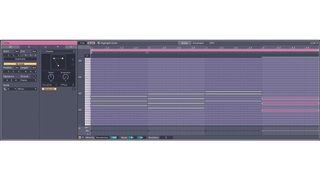
UI changes aside, one of Live 12’s most eye-catching additions is its suite of generative MIDI tools. These are an assortment of features within MIDI clips that are divided into two categories: Generators, which will fill an empty clip with MIDI data, and Transformations, which will alter existing MIDI patterns. Within each of these categories are a variety of tools aimed at different use-cases. Generators, for example, include tools designed to build percussive patterns (Rhythm), melodies (Seed), chords (Stacks) or arpeggiated riffs (Shape). For Suite owners, these are expanded with the ability to use Max MIDI generators within clips too.
Transformations can do things like arpeggiate chords, adjust the quantisation or humanisation of notes, alter the position and timing of MIDI events, or embellish patterns with flams and ghost notes.
These MIDI tools are a fantastic, inspiring addition to the DAW, that practically beg you to lose hours down creative rabbit holes exploring their full potential. That being said, the implementation lacks refinement in places. Creating progressions with the Stacks chord generator, for example, involves manually altering the shape and root note of each chord, and it feels like it’s crying out for a function to auto-generate common progressions. It’s also a shame that the chord shapes aren’t more clearly labelled with their names, which could provide a handy learning tool. Elsewhere, the general setup also makes it a little too easy to get lost and accidentally overwrite or transform notes you didn’t mean to alter. This can be easily undone, but has the effect of making the workflow feel fiddly and a little messy.
Live 12 also introduces a new master scale setting, whereby users can set a scale for the whole project, which is then automatically applied to new clips. This is handy, but it’s also easy to override by setting scales within individual MIDI or audio clips, allowing users to change key/scale mid-project or track, which is useful for live performance. These scale settings take on added importance as of Live 12, as the DAW adds a ‘scale awareness’ mode to several of its stock devices. This allows for certain pitch-based parameters – such as MIDI effects, synth oscillator tuning, pitch-shift effects – to be locked to the current scale. Not only does this avoid unwanted harmonic clashes (although it can be turned off, to avoid things sounding too ‘perfect’) it also means that changing from a clip with one assigned key/scale to another will cause all relevant devices to follow suit.
On a similar front, Live 12 also adds the ability to work with micro-tunings and non-Western scales. This is accessed via a tuning pool that functions in a similar manner to the Groove Pool. Engaging a tuning from this pool deactivates the global scale – which makes sense, since the two functions are effectively at odds with one another – and applies the tuning across all project clips. This pool also allows users to edit and import custom tunings.
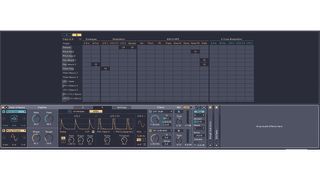
New toys
There’s a lot going on with this update then, and that’s before we even get to the headline devices. Live 12 adds a new synth, Meld, a new effect, Roar, and an update to the popular Max instrument Granulator.
Meld is a dual-engine synth with a variety of interesting oscillator modes that lean into digital sounds and textures. These range from simple virtual analogue waves through to creatively filtered noise, generators that produce interesting harmonic overtones, and animated rain and water textures. It also boasts filters that can double-up as resonators, distortions and comb filter effects, plus a powerful modulation setup that lets users apply transformations to the LFOs and route elements from one engine to the other. Both in terms of structure and sound, Meld reminds me a lot of Arturia’s MiniFreak synth, which is no bad thing; both instruments combine complex digital synthesis ideas into a surprisingly approachable and fun package.
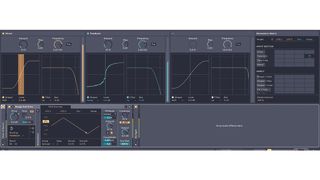
Roar is a multi-stage distortion, which allows up-to three stages of distortion to be arranged in a variety of ways. These can run in serial or parallel, be applied individually to different frequency bands, or to the mid and side of a signal. It also has an internal feedback routing, allowing Roar to act like a simple delay, whereby distortion can be applied to the input and feedback loop individually. Like Meld, copious, flexible modulation capabilities do a lot to bring Roar to life, allowing it to work for broad applications such as refining the character of drum loops, adding resonant glitches to pads and creating lo-fi dub echoes.
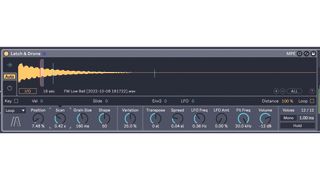
The latest version of Granulator – more of a new instrument than a straight update – both refines and simplifies the granular concept, making it more approachable without sacrificing its depth. The biggest enhancements are the addition of MPE and improved capture capabilities that allow users to record directly into the effect.
Last but not least, it’s worth mentioning the work Ableton has put into adding to Live’s accessibility for version 12. This includes screen reader support, along with improved shortcuts, which make it all the easier to access every element of Live without using a mouse. I’m not somebody who requires either of these functions to use Live, so can’t really comment on how effectively they’ve been implemented, but it’s pleasing to see Ableton aim for advances in this area.

Pack it up
Naturally, Live 12 Suite adds additional content downloadable in the form of Packs from Ableton’s site. There are two new Packs for users to download. The first, Lost and Found, is a percussive-leaning sample pack that draws heavily on recordings of household objects and material textures. These come organised into some nicely curated, fun drum kits and esoteric instruments.
The second, and more interesting, is the Max-powered Performance Pack: a bundle of four customisable devices that are essentially aimed at patching up some of the more advanced and niche gaps in Live’s performance workflow. For controller users – and Push in particular – Performer offers a handy tool that lets you configure banks of top-level macro controls. It can also be used to set up complex, multi-destination modulation that goes beyond the slightly basic modulators in Live’s stock library. Beyond this, there are also tools aimed at facilitating live looping in the arrangement view, plus creating on-the-fly arrangements and variations.
What about Push?
How does Push 3 fare with Live 12? As a controller, the new devices seem tailor-made for use with Push’s MPE interface. Meld and Granulator 3 make great use of the expressive pads and are easy to control with Push’s rotaries. Roar’s animated distortion looks great on Push’s screen too. At the time of writing, none of the new features or devices have rolled out for Push’s standalone OS. Ableton tells us this will be rectified though. Sadly, there’s also no way to interact with the MIDI generator/transformation tools using Push – in controller or standalone configuration – which is something we’d love to see implemented.
To update or not to update?
In all, Live 12 has a lot to shout about. Compared to some previous iterations, there is a lot here that feels fresh and like it could have a significant impact on how users interact with the DAW. Some of these advancements feel like they’re due a little refinement in future updates – we wouldn’t be surprised to see subtle tweaks to how the MIDI tools or browser behave, which would be welcome. However you use Live though, there are new features here likely to appeal.
Over the years, Ableton has become known for releasing updates that are incremental and often subtle, rather than revolutionary, meaning it can be difficult to decide how much it’s worth paying for the latest version. If you’re a user who’s been holding off on upgrading, Live 12 is the one you’ve been waiting for.
MusicRadar verdict: While some new features are better implemented than others, Live 12 is a generous update stuffed with ideas and real potential.
Ableton Live 12.1 Update
Ableton’s latest ‘point’ update arrives a little over half a year on from the announcement of Live 12, and adds a remarkably substantial bundle of content for a free update. Live 12.1 – in public beta at the time of writing – brings two new devices as well as several significant workflow improvements.
The first of those new devices is Auto Shift, a pitch tracking and correction tool that plugs one of the most significant holes in Live’s tool kit. This largely works as expected, adjusting incoming audio to match a set scale, with options to shift both the pitch and formats of that audio. In terms of both capabilities and sound quality, it’s on a par with third-party rivals rather than offering a leap forward, but it’s pleasingly easy on the CPU – even in low-latency ‘live’ mode – and works well with Live 12’s new scale awareness functionality.

Arguably more exciting is the new Drum Sampler device. This is a new one-shot sampler, like an even simpler version of Simpler, formatted specifically for use with percussive sounds. While the general layout is more simplistic than Live’s other samplers, with just an AHD amp envelope available for shaping and minimal tools for sample adjustment, Drum Sampler does add a new FX slot. This sits just before the device’s filter, and can be used for one of multiple processing functions, including looping, time-stretching, ring modulation, bitcrushing, as well as applying a pitch envelope, attack punch or a sub boost. In all cases, these effects can be adjusted using a simple X/Y pad. In all it’s an excellent device, and while it might be a little too simplistic for some sampling situations, you still have access to both Sampler and Simpler in Live’s device list.
Beyond these new devices, Live 12.1 also revamps the existing Saturator and Limiter devices. The former has a new-look interface with vastly improved controls for adjusting the frequency ‘colour’ of the effect. Live’s simplistic Limiter, meanwhile, gains features including a mid/side mode and a loudness-boosting Maximizer. Both devices have become much more flexible and capable of better-sounding results.
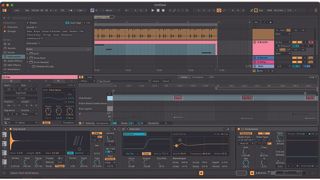
Workflow-wise, Ableton has added more to the MIDI improvements of Live 12. There are three new MIDI transformation tools. Chop will divide a MIDI note into a selected number of slices, Glissando inserts MPE pitch bends between selected notes, while LFO applies modulation to MPE slide, pitch and pressure messages – this latter tool rapidly becoming a favourite of mine.
The users that arguably benefit the most from Live 12.1, however, are those of the standalone version of Push. Alongside the desktop version of Live 12.1, Ableton is also wheeling out firmware for the device that fixes a number of notable bugbears, adding the ability to easily group sounds as well as vastly improved macro capabilities.
Finally, the browser now applies automatic tags to user samples and third party plugins, which hugely improves the usability of the updated browser.
If you’re a user that has been on the fence about the jump to Live 12, there may well be enough here to convince you.
MusicRadar verdict: A worthwhile update, which brings two new devices as well as several significant workflow improvements.
Ableton Live 12 Suite: The web says
"Ableton Live 12 is an exciting step forward for the flagship software. There is enough new here to warrant the upgrade cost, even if you’re just excited about Roar, Meld, and the updated MIDI clip editing and generative tools."
SonicScoop
Ableton Live 12 Suite: Hands-on demos
Ableton
Beat Academy
sonicstate
Seed To Stage
Ableton Live 12 Suite: Specifications
- KEY FEATURES: DAW update adding new tools, sound content, UI and workflow changes.
- PRICING: Live Suite: £539, Live Standard: £259, Live Intro: £69. Check site for upgrade offers.
- CONTACT: Ableton
I'm Editor-in-Chief of Music Technology, working with Future Music, Computer Music, Electronic Musician and MusicRadar. I've been messing around with music tech in various forms for over two decades. I've also spent the last 10 years forgetting how to play guitar. Find me in the chillout room at raves complaining that it's past my bedtime.

“These American originals, celebrated for their rich histories and unparalleled sound, continue to set the standard”: Gibson gives its SJ-200 and J-45 acoustics an exclusive Blueberry Burst makeover

“Incredibly musical and vocal… the way it was always supposed to be”: Xotic Effects unveils the XW-2 in metallic blue – a wah with the wow factor and a “beyond vintage” take on the Clyde McCoy classic

“He was a sort of eccentric. He smoked a pipe while he recorded. We got there, and then we just started working things out”: Andy Summers on his surprise ‘new’ collab album with Robert Fripp




